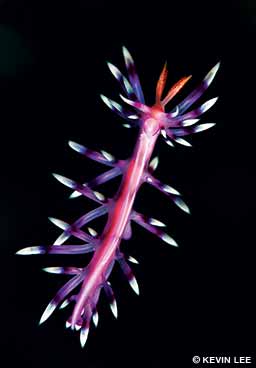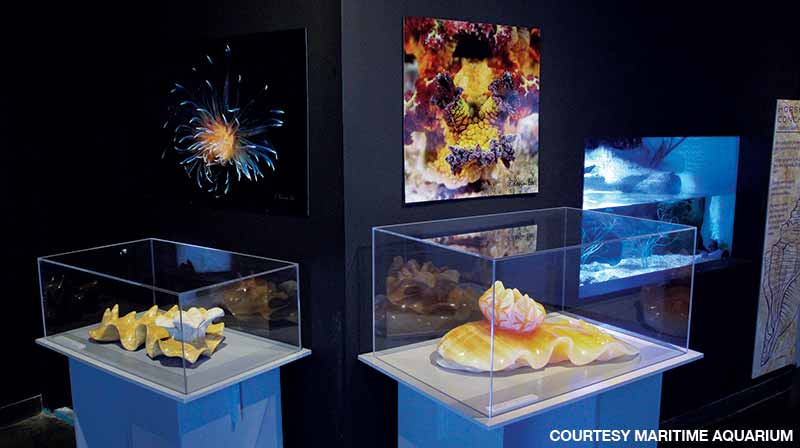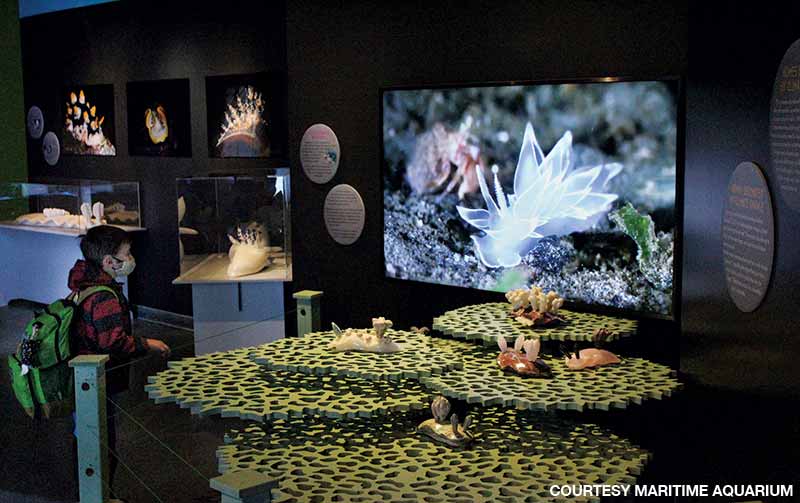Many divers love nudibranchs for their unique shapes, bright colors and difficulty to spot underwater. People who are intrigued with the science behind what they see may also appreciate these animals for their amazing adaptations, such as the ability to incorporate toxins from their prey into their own bodies.

Now there is more to appreciate about these beloved sea slugs. At the Maritime Aquarium in Norwalk, Connecticut, nudibranchs have become storytellers for an issue facing our oceans that is difficult to understand yet imperative to know about: global climate change. The aquarium has taken a unique approach to educate the public on this global threat. Their new exhibit, A Slug’s Life: Facing the Climate Endgame, showcases the adored mollusk and runs through Sept. 6, 2021. The exhibit’s specific intent is to help guests understand the warnings that changing slug populations provide about the health of their habitats.
The aquarium chose nudibranchs as the ambassador for this exhibit because of their unique beauty and status as an indicator species. They respond to environmental changes within their habitat faster than many other animals do. A sudden increase or decrease in nudibranch abundance could indicate environmental fluctuations associated with climate change. Coral reefs are the most common home for nudibranchs, so nudibranch populations can provide information about a habitat that’s highly susceptible to increasing temperatures and decreasing pH levels.
Partly due to their small size — less than 3 inches on average, according to Barrett Christie, Maritime Aquarium’s director of animal husbandry — nudibranchs are not often the main attraction at aquariums. While slowing down and looking closely at these animals is certainly part of the allure, Maritime Aquarium had to get creative about how to draw guests to the exhibit.
In addition to incorporating other mollusks such as an octopus, conchs and sea hares, A Slug’s Life sets itself apart from similar displays with the integration of photography and sculpture. There are photographs of nudibranchs from around the world, including the work of Gordon Tillen (the Philippines), Keith Ellenbogen (New York City), Kevin Lee (California), Alicia Hermosillo (Mexico), Jim Anderson (Scotland) and Emanuel Gonçalves (Portugal). There are also onyx and marble sculptures by Connecticut artist Gar Waterman.

“Gar’s large sculptures announce right away that there’s something different and unusual here. And creating that intrigue is important,” Tom Frankie, director of exhibits, explained. “We want people to want to find the nudibranchs and to see the other animals displayed. In addition, the sculptures, as well as the beautiful photographs, convey how wildly varied nudibranchs are in their shapes and colors. They’re so unique and diverse that they’re worthy of being represented as art forms. The exhibit encouraging guests to appreciate nudibranchs opens up ways for us to communicate about the environmental threats to reef communities and our oceans at large from climate change.”
Waterman, who is possibly the only sculptor in the world who creates sea slugs from stone, further identified the importance of incorporating art into the exhibit: “Art can be an extremely useful tool in engaging an audience, and art and science combined can be more effective educators than either on their own.”
“Humans are attracted to art,” photographer Lee said. “Combining the art of sculpture with brilliant photographic images in an exhibit is very effective because it attracts, entertains and, most important, educates visitors about our marine world.”

The exhibit has seven live displays featuring two nudibranch species: the lettuce nudibranch and the pygmy sea hare. Other mollusks showcased include a common octopus, California sea hares, horse conch, red abalone, giant clams, cowries and Indo-Pacific snails. Another vital component of the exhibit is a display of live freshwater mussels, which Christie said are one of the most endangered animals in North America.
As for the art, Waterman purposefully sculpted these tiny animals on a large scale to allow guests to view the nudibranch’s unique details. Frankie explained that he similarly approached the photography display.
“I wanted to blow up the images so people can appreciate these unusual, beautiful animals,” Frankie said. “But we stayed away from closeups of cerata and other nudibranch body features so our guests can see those features in the context of the entire animal — the same way that Gar’s sculptures capture the complete form.”

Some photographs are physically displayed, while others will be viewable on a 60-foot digital screen. There is also an outreach component to this exhibit, including a photo competition.
The idea of A Slug’s Life: Facing the Climate Endgame is to educate and create a sense of awareness that promotes behavioral changes. “By giving people creatively presented examples of biodiversity and reminding them that this is what we have to lose,” Waterman explained, “there is a chance to strike a chord of environmental awareness that we can hope might lead to proactive involvement.”
Visitors will no doubt leave this exhibit wanting to do their part to protect the beloved nudibranch. Christie explained that each of us could do something to make a difference and protect their habitat.
“The easiest, smartest ways to do that,” he said, “are to reduce your use of single-use plastics, find ways to reduce your carbon footprint and commit to purchasing only sustainable seafood.” He also pointed out that nudibranchs are difficult to maintain in tanks and advises home aquarists to “admire these beautiful creatures on the reef while diving or through art and photography rather than trying to keep them at home.”
Explore More
Watch Gar Waterman carve a nudibranch out of stone.
© Alert Diver — Q2 2021